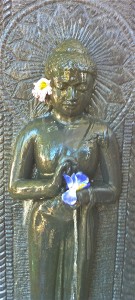 How many schools of Buddhism are there? There were the eighteen schools of early Buddhism: Saravastivadin, Sautranika, Dharmaguptaka, etc. There are the three vehicles: Hinayana, Mahayana, and Vajrayana. There are the various schools of Japanese Buddhism: Pure Land (Jodo-shu and Jodo-shinshu), Shingon, Tendai, Nichiren, Soka Gakkai, Soto and Rinzai Zen. There are the major schools of Tibetan Buddhism: Gelug, Kagyu, Nyingma, and Sakyu. There are the diverse forms of Theravada: Thai Forest, lay Burmese, the various state Buddhisms. There are the ten schools of Chinese Buddhism: T’ien T’ai, Chan (Northern and Southern), Ching-t’u, etc. We haven’t even gotten to Korea or Viet Nam! I’m sure I’ve left out a lot…
How many schools of Buddhism are there? There were the eighteen schools of early Buddhism: Saravastivadin, Sautranika, Dharmaguptaka, etc. There are the three vehicles: Hinayana, Mahayana, and Vajrayana. There are the various schools of Japanese Buddhism: Pure Land (Jodo-shu and Jodo-shinshu), Shingon, Tendai, Nichiren, Soka Gakkai, Soto and Rinzai Zen. There are the major schools of Tibetan Buddhism: Gelug, Kagyu, Nyingma, and Sakyu. There are the diverse forms of Theravada: Thai Forest, lay Burmese, the various state Buddhisms. There are the ten schools of Chinese Buddhism: T’ien T’ai, Chan (Northern and Southern), Ching-t’u, etc. We haven’t even gotten to Korea or Viet Nam! I’m sure I’ve left out a lot…
Which one of these is the True Buddhism? You could argue, as Joseph Goldstein has [ref] Goldstein. J. (2002). One Dharma: The Emerging Western Buddhism. HarperSanFrancisco. [/ref], that they are all outward expressions of One Dharma, but they are really quite heterodox and heteropractic. The more one learns about Buddhism, the more one becomes aware that there is no one thing called Buddhism, but a diversity of cultures of awakening inspired and informed by the teachings of the Buddha.
It’s the same with all religions. Judaism has always been a broad stream of competing interpretations of tradition. Today that Judaic stream includes such diverse forms as Hasidism, Modern Orthodoxy, Conservativism, and the Reform and Reconstructionist movements. Similarly, Catholicism, Eastern Orthodoxy, the mainline, fundamentalist, and evangelical branches of Protestantism, Unitarianism, Mormonism, Christian Science, Seventh-Day Adventism, and the Jehovah’s Witnesses all coexist under the broad umbrella of Christianity. Which is the true Judaism? What the true Christianity?
Religions are not static entities, but evolving, pluralistic networks inspired by the ideas of their founders, who in turn were inspired by traditions that preceded them. Christ emerged from within the Jewish tradition, the Buddha from within the Indian ō›ranmana movement. Religions are, as Buddhists might say, conditioned phenomena that are impermanent and have no self-nature.
We have no way of knowing precisely what the Buddha said. The teachings of the Pali canon were written down centuries after the buddha’s parinirvana. The Mahayana sutras, most written centuries after the Pali canon, also claim to be Buddhavacana, the Word of the Buddha, just as the Bible and Qur’an claim to be the Word of God.
Even if we knew exactly what the Buddha said, there’s no reason to assume everything he said was true. He may have been Enlightened, but he was still just a man: a man who grew up within a particular historical era, socioeconomic class, culture, and gender. His knowledge of the world was limited by the cosmology, science, geography, biology, economics, psychology, and politics of the time. He didn’t know about quarks, quasars, molecules, bacteria, evolution, neurobiology, macroeconomics, or North America. He grew up within a culture that believed in devas, brahmas, ghosts and demons, and that assumed Mount Meru was the center of the geographical world. Whenever we approach a Buddhist text, we can’t help approaching it as twenty-first century inhabitants of our own contemporary cultures. We must use our own knowledge base, our ability to reason, and our own lived experience of Buddhist practice to reassess the value, meaning, and intention of Buddhist teachings and texts.
It always saddens me when one school of Buddhism assumes it is The True School and denigrates others. This has happened throughout Buddhism’s history, just as it happens in all religions. Nichiren vigorously attacked Zen in the 13th Century, and Mahayana has historically denigrated Theravada as a ”lesser vehicle”, while Theravada has complained about Mahayana and Vajrayana revisionism. The various Buddhisms have always been marked by reinterpretation and attempts to reinstate orthodoxy.
It also always saddens me when people I respect and admire attack each other. The impetus for this post is B. Alan Wallace’s recent attack on Stephen Batchelor’s views In Mandala, the FPMT official publication. In that essay, Wallace states that Batchelor offers a ”false facsimile” of the Buddha’s teachings and his writings are a ”near enemy” of Buddhism.
Wallace and Batchelor were monks together in India and Switzerland. I’ve had the pleasure of having spoken to and attended talks by both of them over the years. They are both thoughtful, challenging, and inspiring teachers, and I’ve learned much from each of them. I understand where and why Wallace disagrees with Batchelor, and while my own views are much closer to Batchelor’s (this Blog is called the Existential Buddhist, after all!) I think Wallace makes some valid criticisms. It’s a big leap, however, from saying one disagrees with someone else to saying they are an enemy. There’s a lot of room for interpretation in Buddhism. We’re a big tent. Let a thousand flowers bloom, a thousand schools of thought contend! Lighten up, Alan! In the words of the famous contemporary American philosopher, Rodney King, ”Can’t we all just get along?”
